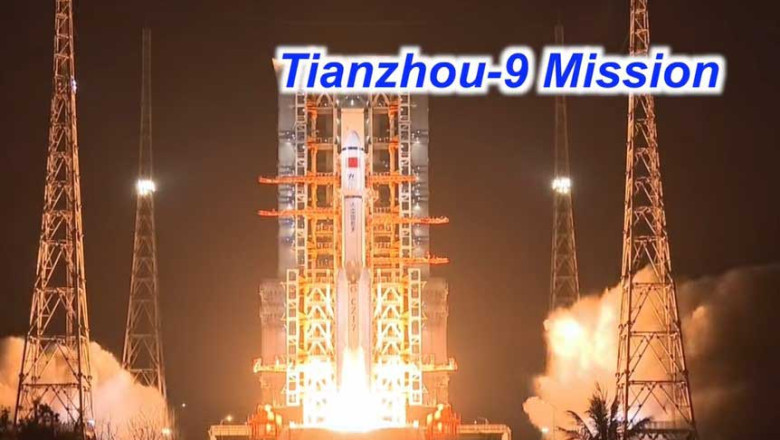
views
Over the past decade, China has rapidly expanded its capabilities in space exploration, particularly through the development of its autonomous cargo spacecraft series known as Tianzhou (meaning “Heavenly Vessel”). From the inaugural launch of Tianzhou-1 in 2017 to the latest missions such as Tianzhou-9 in 2025, China’s space cargo program has evolved from a key technological demonstration to a mature and indispensable component of its ambitious Tiangong space station project. This progression showcases China’s growing mastery in space logistics, automated rendezvous and docking, and in-orbit refueling—critical technologies for sustained human spaceflight.
The Genesis: Tianzhou-1 and Foundational Technologies
China’s journey with Tianzhou began with the launch of Tianzhou-1 on April 20, 2017. As China’s first automated cargo spacecraft, Tianzhou-1 was designed to test and validate a suite of new capabilities essential for sustaining a long-term human presence in low Earth orbit (LEO). These capabilities included:
-
Autonomous rendezvous and docking with the Tiangong-2 space lab
-
On-orbit propellant transfer
-
Cargo transfer in pressurized and unpressurized environments
Tianzhou-1 was an evolutionary derivative of the Tiangong-1 prototype space station but repurposed to function firmly as a cargo freighter. The spacecraft’s design featured multiple cargo compartments tailored to store living supplies, scientific equipment, and fuel tanks. When Tianzhou-1 successfully docked with Tiangong-2 and performed propellant transfer for the first time, it marked a major milestone for China’s space program—signaling its entrance into the ranks of spacefaring nations capable of automated, robotic logistics missions in orbit.
Scaling Up: Tianzhou 2 through Tianzhou 5
After proving the basic concepts, China accelerated the Tianzhou series with Tianzhou-2 (May 2021), the first vessel to dock with the newly launched Tianhe Core Module (TCM) of the future Tiangong space station. Unlike the relatively short-term Tiangong-2 mission, the Tiangong station was envisioned as a modular, multi-purpose laboratory designed for at least a decade of operation.
Tianzhou-2 carried nearly 6,000 kg of supplies — including propellant, water, oxygen, food, scientific payloads, and station equipment. Autonomous rendezvous, docking, and supply transfer operations became standard operational capabilities. These missions supported manned expeditions led by crews aboard the Shenzhou spacecraft, facilitating longer duration spaceflights.
Subsequent Tianzhou missions refined the design, increasing cargo mass capacity and improving operational efficiency. Early capacity hovered around 6,500 kg per flight. The Freighter evolved to carry:
-
Fuel for the station’s propulsion and attitude control thrusters
-
Critical life support consumables
-
Scientific equipment for experiments in microgravity
Each mission further demonstrated the precision of China’s fully automated rendezvous and docking technology, with docking times often reduced to hours post-launch, underscoring operational readiness.
Towards a Mature System: Tianzhou 6, 7, and 8
By the time Tianzhou-6, 7, and 8 launched between 2023 and early 2025, China’s cargo freighters had become an integral part of continuous Tiangong station operations. Several important upgrades were incorporated:
-
Increased payload capacity from 6,500 kg to approximately 7,400 kg, a nearly 15% rise enabling fewer missions to supply the station annually
-
Enhanced automated docking systems allowing rapid soft and hard dockings with improved reliability
-
Modular cargo compartments optimized for mixed contents, including pressurized and unpressurized cargo, large equipment components, and new spacesuits
-
Improved propulsion systems ensuring fine attitude adjustments during approach and extended orbital maneuvers
The Long March 7 Y10 launch vehicle consistently deployed these vessels with high precision. Tianzhou missions increasingly supported routine crew exchanges aboard Shenzhou flights, ensuring the Tiangong station remained fully operational with fresh supplies, fuel, and equipment.
Tianzhou-9 and the Operational Maturity of China’s Space Cargo Fleet
The launch of Tianzhou-9 on July 15, 2025, marked another watershed moment. Carrying an estimated 6.5 to 7.2 tons of supplies—one of the heaviest payloads to date—the resupply mission utilized the Long March 7 Y10 rocket and demonstrated extraordinary rendezvous agility by docking with the Tianhe core module just three hours after liftoff.
Tianzhou-9’s cargo included:
-
Advanced scientific experiment hardware for upcoming research campaigns onboard Tiangong
-
Fresh consumables and life support materials ensuring crew sustainability
-
High-capacity propellant to maintain and boost the station’s orbit
This mission underscored the robustness and reliability of China’s autonomous spacecraft fleet and its growing independence from international partners. Tianzhou-9’s successful fast rendezvous also showcased perfected mission planning and control, enabling rapid resupply within a tight orbital window.
Technological Innovations Underpinning Tianzhou
The Tianzhou spacecraft represent a significant technical achievement, combining innovations with proven aerospace heritage:
-
Automated Rendezvous and Docking: Employing rendezvous radar, LIDAR, visual navigation sensors, and sophisticated guidance algorithms, Tianzhou ships autonomously approach and dock with the space station at orbital speeds of nearly 27,000 km/h.
-
On-Orbit Refueling: A standout capability, Tianzhou transfers propellant to the Tianhe core module’s tanks to enable orbital adjustments and attitude control, dramatically extending station lifespan.
-
Cargo Flexibility: Multi-bay storage and modular design facilitate varied cargo types—pressurized for crew supplies and experiments, and unpressurized for external payloads and hardware.
-
Reliability and Reusability: While not fully reusable, the design maximizes mission success rates and includes contingencies for abort or safe disposal after use.
Significance and Future Prospects
China’s rapid success with Tianzhou cargo vessels has proved pivotal in sustaining the Tianong space station, a symbol of the nation’s independent human spaceflight ambitions. The progression from Tianzhou-1 to Tianzhou-9 illustrates:
-
The maturation of autonomous spacefreight technologies akin to Russia’s Progress or the US’s Cygnus vehicles
-
China’s capability to maintain long-term orbital infrastructure without dependence on foreign cargo providers
-
The foundation for expanded missions, including potential lunar logistics services or deep space payload delivery
Going forward, Tianzhou is expected to evolve further with:
-
Increased payload capacity to match station expansion
-
More sophisticated robotic manipulation for cargo handling
-
Integration with future Chinese lunar exploration assets for in-space cargo transfer
Final thoughts
From a bold technological demonstration with Tianzhou-1 to the operationally mature and reliable missions of Tianzhou-9, China’s space cargo program has climbed the ranks to become one of the most advanced and capable in the world. This fleet underpins the nation’s vision of a sustained human presence in space, supports cutting-edge scientific research aboard Tiangong, and reinforces China as a formidable player in the future of orbital logistics and exploration.
The rise of Tianzhou exemplifies how focused innovation combined with incremental progress can build complex space infrastructure, securing China’s foothold in the new era of space station operations and beyond.




















Comments
0 comment